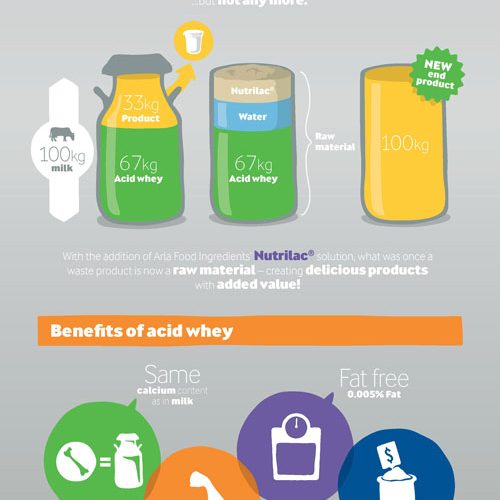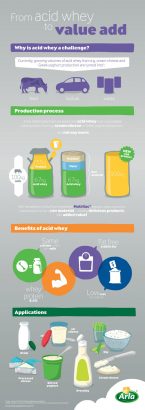Acid whey: Providing solutions for dairy waste
- Like
- Digg
- Del
- Tumblr
- VKontakte
- Buffer
- Love This
- Odnoklassniki
- Meneame
- Blogger
- Amazon
- Yahoo Mail
- Gmail
- AOL
- Newsvine
- HackerNews
- Evernote
- MySpace
- Mail.ru
- Viadeo
- Line
- Comments
- Yummly
- SMS
- Viber
- Telegram
- Subscribe
- Skype
- Facebook Messenger
- Kakao
- LiveJournal
- Yammer
- Edgar
- Fintel
- Mix
- Instapaper
- Copy Link
Posted: 15 August 2016 | New Food | No comments yet
In the first of two infographics courtesy of Arla Foods, we explore how acid whey can be transformed into new, exciting products offering a solution to the increasing issue of waste in the dairy industry.


In the first of two infographics courtesy of Arla Foods Ingredients, we explore how acid whey can be transformed into new, exciting products offering a solution to the increasing issue of waste in the dairy industry.
With consumer demand for products such as Greek yoghurt and cream cheese on the up, manufacturers face the increasingly-prominent issue of dealing with acid whey, a once-considered unfortunate by-product of dairy production.
Why is it problematic?
For every 7,000 gallons of milk used in making Greek yogurt, it is estimated that almost 5,000 gallons of acid whey is produced, according to a 2013 Cornell University report.
The substance is considered to cause environmental problems, disrupting the natural balance of rivers and streams and currently companies often pay for it to be drained or dumped across farmers’ fields. Some are even offloading it to anaerobic digesters where it is fermented to produce methane.
Companies such as Arla are now developing technology to actively transform acid whey into new products
While ‘sweet’ whey can easily be dealt with and is often be found in body-building products or on the shelves of a high-street health shop, the ‘acid’ variety contains a lot less protein that its sweeter cousin.
Both comprised of 95% water, it remains the other properties of acid whey such as lactose, lactic acid, calcium, phosphorus and galactose that create issues when trying to turn it into more than just a by-product of Greek yoghurt of cream cheese.
Transforming acid whey
Companies such as Arla are now developing technology to actively transform the substance into new products as shown by the following infographic, perhaps providing a lasting solution to the potential environmental problem of acid whey.





